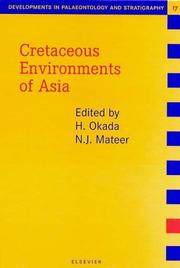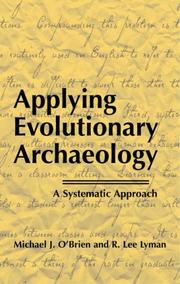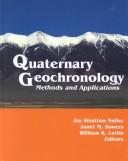| Listing 1 - 4 of 4 |
Sort by
|

ISBN: 0632044446 Year: 2000 Publisher: Oxford Blackwell Science
Abstract | Keywords | Export | Availability | Bookmark
 Loading...
Loading...Choose an application
- Reference Manager
- EndNote
- RefWorks (Direct export to RefWorks)
Paleontology. --- Paleontology --- Fossilogy --- Fossilology --- Palaeontology --- Paleontology, Zoological --- Paleozoology --- Historical geology --- Zoology --- Fossils --- Prehistoric animals in motion pictures

ISBN: 0444502769 9786611311551 1281311553 0080530095 Year: 2000 Publisher: Amsterdam ; New York : Elsevier,
Abstract | Keywords | Export | Availability | Bookmark
 Loading...
Loading...Choose an application
- Reference Manager
- EndNote
- RefWorks (Direct export to RefWorks)
This book presents a synthesis of the principal environmental characteristics of the Cretaceous in East and South Asia. The research was accomplished under IGCP project 350, which deals with the biological, climatological and physical environments of this region during the Cretaceous. This synthesis discusses aspects of stratigraphy, sedimentology, paleontology, geochemistry, tectonics, petrology, mineralogy, and geophysics. The research results are summarised by country, and include Far East Russia, Mongolia, eastern China, Korea, Japan, Philippines, Vietnam, Laos, Cambodia, Thailand, and
Geology, Stratigraphic --- Geology --- Paleontology --- Fossilogy --- Fossilology --- Palaeontology --- Paleontology, Zoological --- Paleozoology --- Historical geology --- Zoology --- Fossils --- Prehistoric animals in motion pictures --- Cretaceous Period

ISBN: 9780306462535 0306462532 9780306474682 0306462540 0306474689 Year: 2000 Publisher: New York, New York : Kluwer Academic/Plenum,
Abstract | Keywords | Export | Availability | Bookmark
 Loading...
Loading...Choose an application
- Reference Manager
- EndNote
- RefWorks (Direct export to RefWorks)
Anthropology, and by extension archaeology, has had a long-standing interest in evolution in one or several of its various guises. Pick up any lengthy treatise on humankind written in the last quarter of the nineteenth century and the chances are good that the word evolution will appear somewhere in the text. If for some reason the word itself is absent, the odds are excellent that at least the concept of change over time will have a central role in the discussion. After one of the preeminent (and often vilified) social scientists of the nineteenth century, Herbert Spencer, popularized the term in the 1850s, evolution became more or less a household word, usually being used synonymously with change, albeit change over extended periods of time. Later, through the writings of Edward Burnett Tylor, Lewis Henry Morgan, and others, the notion of evolution as it applies to stages of social and political development assumed a prominent position in anthropological disc- sions. To those with only a passing knowledge of American anthropology, it often appears that evolutionism in the early twentieth century went into a decline at the hands of Franz Boas and those of similar outlook, often termed particularists. However, it was not evolutionism that was under attack but rather comparativism— an approach that used the ethnographic present as a key to understanding how and why past peoples lived the way they did (Boas 1896).
Archaeology --- Evolution. --- Anthropology, Prehistoric. --- Archéologie --- Evolution --- Anthropologie préhistorique --- Methodology. --- Philosophy. --- Méthodologie --- Philosophie --- Anthropology. --- Archaeology. --- Paleontology. --- Sedimentology. --- Social sciences. --- Anthropology, Prehistoric --- History & Archaeology --- Methodology --- Philosophy --- Social Sciences. --- Creation --- Emergence (Philosophy) --- Teleology --- Prehistoric anthropology --- Paleontology . --- Fossilogy --- Fossilology --- Palaeontology --- Paleontology, Zoological --- Paleozoology --- Historical geology --- Zoology --- Fossils --- Prehistoric animals in motion pictures --- Petrology --- Human beings --- Archeology --- Anthropology --- Auxiliary sciences of history --- History --- Antiquities

ISBN: 9780875909509 0875909507 Year: 2000 Volume: 4 Publisher: Washington, DC : American geophysical union,
Abstract | Keywords | Export | Availability | Bookmark
 Loading...
Loading...Choose an application
- Reference Manager
- EndNote
- RefWorks (Direct export to RefWorks)
Geology, Stratigraphic --- Paleontology --- Geochronometry. --- Stratigraphie --- Paléontologie --- Géochronométrie --- 550.4 --- 550.93 --- 551.79 --- -Paleontology --- -Geochronometry --- Dating of fossils --- Dating of rocks --- Fossils --- Geological chronometry --- Geological time --- Rocks --- Time measurements --- Fossilogy --- Fossilology --- Palaeontology --- Paleontology, Zoological --- Paleozoology --- Historical geology --- Zoology --- Prehistoric animals in motion pictures --- Age of rocks --- Stratigraphic geology --- Physical geology --- Geochemistry --- Geochronology. Geological dating. Absolute geological age or time determination --- Quaternary. 1 MYBP - Present --- Dating --- Measurement --- Age --- 551.79 Quaternary. 1 MYBP - Present --- 550.93 Geochronology. Geological dating. Absolute geological age or time determination --- 550.4 Geochemistry --- Paléontologie --- Géochronométrie --- Geochronometry --- Quaternary Period
| Listing 1 - 4 of 4 |
Sort by
|

 Search
Search Feedback
Feedback About UniCat
About UniCat  Help
Help News
News